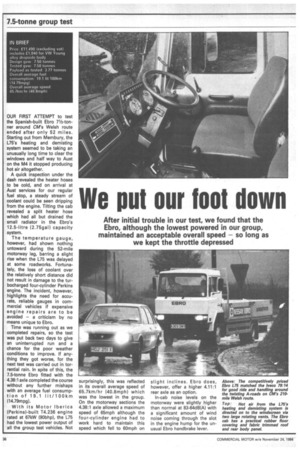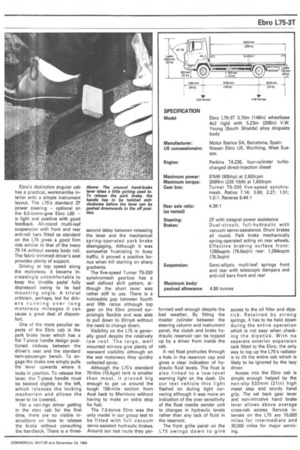We put our loot down
Page 38

Page 39

If you've noticed an error in this article please click here to report it so we can fix it.
After initial trouble in our test, we found that the Ebro, although the lowest powered in our group, maintained an acceptable overall speed — so long as we kept the throttle depressed
OUR FIRST ATTEMPT to test the Spanish-built Ebro 71/2-tonner around CM's Welsh route ended after only 52 miles. Starting out from Membury, the L75's heating and demisting system seemed to be taking an unusually long time to clear the windows and half way to Aust on the M4 it stopped producing hot air altogether.
A quick inspection under the dash revealed the heater hoses to be cold, and on arrival at Aust services for our regular fuel stop, a steady stream of coolant could be seen dripping from the engine. Tilting the cab revealed a split heater hose which had all but drained the small radiator in the Ebro's 12.5-litre (2.75gal) capacity system.
The temperature gauge, however, had shown nothing untoward during the 52-mile motorway leg, barring a slight rise when the L75 was delayed at some roadworks. Fortunately, the loss of coolant over the relatively short distance did not result in damage to the turbocharged four-cylinder Perkins engine. The incident, however, highlights the need for accurate, reliable gauges in commercial vehicles if expensive engine repairs are to be avoided — a criticism by no means unique to Ebro.
Time was running out as we completed repairs, so the test was put back two days to give an uninterrupted run and a chance for the poor weather conditions to improve. If anything they got worse, for the next test was carried out in torrential rain. In spite of this, the 7.5-tonne Ebro fitted with the 4.38:1 axle completed the course without any further mishaps with an average fuel consumption of 19.1 lit/1 0 Okm (14.79mpg).
With its Motor lberica (Perkins)-built T4.236 engine rated at 67kW (90bhp), the L75 had the lowest power output of all the group test vehicles. Not surprisingly, this was reflected in its overall average speed of 65.7km/hr (40.8mph) which was the lowest in the group. On the motorway sections the 4.38:1 axle allowed a maximum speed of 65mph although the four-cylinder engine had to work hard to maintain this speed which fell to 60mph on slight inclines. Ebro does, however, offer a higher 4.11:1 rear axle as an option.
In-cab noise levels on the motorway were slightly higher than normal at 83-84dB(A) with a significant amount of wind noise coming through the slot in the engine hump for the unusual Ebro handbrake lever. Ebro's distinctive angular cab has a practical, workmanlike interior with a simple instrument layout. The L75's standard ZF power steering — optional on the 6.0-tonne-gvw Ebro L60 — is light and positive with good feedback. All-round multi-leaf suspension with front and rear anti-roll bars fitted as standard on the L75 gives a good firm ride similar to that of the lveco 79:14 without excess body roll. The fabric trimmed driver's seat provides plenty of support.
Driving at top speed along the motorway, it became increasingly uncomfortable to keep the throttle pedal fully depressed owing to its bad mounting angle. A trivial criticism, perhaps, but for drivers running over long motorway mileages it can cause a great deal of discomfort.
One of the more peculiar aspects of the Ebro cab is the park brake lever which has a flat T-piece handle design positioned midway between the driver's seat and the standard twin-passenger bench. To engage the brake one simply pulls the lever upwards where it locks in position. To release the lever, the T-piece handle must be twisted slightly to the left, which releases the locking mechanism and allows the lever to be lowered.
For a non-hgv driver getting in the ebro cab for the first time, there are no visible instructions on how to release the brake without consulting the handbook. There is a three second delay between releasing the lever and the mechanical spring-operated park brake disengaging. Although it was somewhat frustrating in busy traffic, it proved a positive bonus when hill starting on sharp gradients.
The five-speed Turner T5-200 synchromesh gearbox has a well defined shift pattern, although the short lever was rather stiff to use. There is a noticeable gap between fourth and fifth ratios although top gear on the Ebro proved surprisingly flexible and was able to pull down to 30mph without the need to change down.
Visibility on the L75 is generally good despite the relatively low roof. The large, well mounted mirrors give plenty of rearward visibility although on the wet motorway they quickly collected spray.
Although the L75's standard 70-litre (15.4gal) tank is smaller than most, it proved big enough to get us around the tough 158-mile section from Aust back to Membury without having to make an extra stop for fuel.
The 7.5-tonne Ebro was the only model in our group test to be fitted with full vacuum servo-assisted hydraulic brakes. Around our test route they per
formed well enough despite the bad weather. By fitting the master cylinder between the steering column and instrument panel, the clutch and brake hydraulic reservoir can be topped up by a driver from inside the cab.
A red float protrudes through a hole in the reservoir cap and gives a clear indication of hydraulic fluid levels. The float is also linked to a low-level warning light on the dash. On our test vehicle this light flashed on during tight cornering although it was more an indication of the over sensitivity of the float needle sender unit to changes in hydraulic levels rather than any lack of fluid in the reservoir.
The front grille panel on the L75 swings down to give access to the oil filler and dipstick. Retained by strong springs, it has to be held down during the entire operation which is not easy when checking the dipstick. With no separate exterior expansion tank fitted to the Ebro, the only way to top up the L75's radiator is to tilt the entire cab which is likely to be ignored by the lazy driver.
Access into the Ebro cab is simple enough helped by the non-slip 533mm (21in) high metal step and sturdy hand grip. The set back gear lever and non-intrusive hand brake lever allows above average cross-cab access. Service intervals on the L75 are 10,000 miles for intermediate and 30,000 miles for major servicing.
































































































